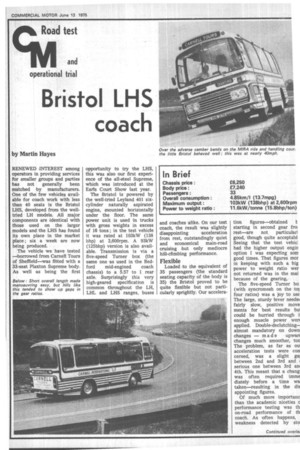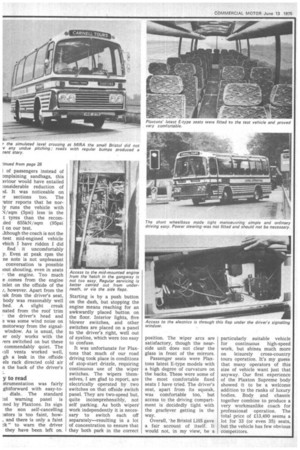Bristol LHS coach
Page 29

Page 30

Page 32

If you've noticed an error in this article please click here to report it so we can fix it.
by Martin Hayes
RENEWED INTEREST among operators in providing services for smaller groups and parties has not generally been matched by manufacturers. One of the few vehicles available for coach work with less than 40 seats is the Bristol LHS, developed from the welltried LH models. All major components are identical with those used on the larger models and the LHS has found its own place in the market place; six a week are now being produced.
The vehicle we have tested —borrowed from Carnell Tours of Sheffield—was fitted with a 33-seat Plaxton Supreme body. As well as being the first
Below: Short overall length made manoeuvring easy, but hills like this tended to show up gaps in the gear ratios.
opportunity to try 'the LHS, this was also our first experience of the all-steel Supreme, Which was introduced at the Earls Court Show last year.
The 'Bristol is powered by the well-tried Leyland 401 sixcylinder naturally aspirated engine, mounted horizontally under the floor. The same power unit is used in trucks with gross weights in excess of 16 tons ; in the test vehicle it was rated at 103kW (138 bhp) at 2,600rpm. A 93kW (125bhp) version is also available. Transmission is via a five-speed Turner box (the same one as used in the Bedford mid-engined coach chassis) to a 5.57 to 1 rear axle. SurpriSingly this very high-geared specification is common throughout the LH, LHL and LHS ranges, buses and coaches alike. On our test coach, the result 'was slightly disappointing 'acceleration from rest, outstandingly quiet and economical main-road cruising but only mediocre hill-climbing performance.
Flexible
Loaded 'to the equivalent of 35 passengers (the standard seating capacity of the body is 35) the Bristol proved to be quite flexible but not particularly sprightly. Our accelera tion figures—obtained t starting in second gear fro rest—are not particulari good, though quite acceptabl Seeing that the test vehici had the higher output engin option I was expecting som good times. That figures mor in keeping wi'th such a 'big power to weight ratio wer not returned was in the mai because of the gearing, The five-speed Turner ho: (with syncromesh on the toi four ratios) was a joy to USE The large, sturdy lever needer fairly slow, positive move ments for best results ,bu.' could be hurried 'through i' enough muscle power wen applied. Double-declutching— almost mandatory on down changes — made upwar( changes much smoother, too The problem, 'as far a:s ou acceleration tests were con cerned, was a slight gaj between 2nd and 3rd and serious one between 3rd an 4th. This meant that a chang was often required imrne diately before a 'time wa taken—resulting in the dis appointing figures.
Of much more importanc than the academic niceties c performance testing was th on-road performance of th coach. As often happens, weakness detected by sto tch at MIRA takes on major nificance on the road. Over Midlands test route, the )s in the gear ratios became too clear. In the hilly secns of route it was common reach the governed maxim speed of 51km/h (32 01.1) in 3rd, change into 4th a then find a swift downange was necessary. On the ig climb out of Broadway:errupted by roadworks— e minimum speed reached 26km/h (16mph), but for Ich of the hill the coach was maximum revs in second .t refused to accept 3rd.
mooth
Fifth gear is very much an 'erdrive and, although the lach cruises very smoothly this ratio, it is not •of much ;e for 'acceleration. On anyting 'approaching hill a iange down to 4th (with its ;ry useful maximum of )km/h (56mph) is called tr. Happily, this is the one ownchange where double eclutching is not really necesiry, and a lightning change an be made if the revs are latched. In fact 4th is the lost typical gear for mainoad overtaking manoeuvres nd for negotiating light raffic in town.
Rather more use of 4th is iecessary than I would like luring motorway cruising.
ven on the relatively flat ection of MI and M45 used or our test I had to drop down gear to maintain speed up ;ome hills. In •fact performance on the motorway was ione too praiseworthy. As well as the severe effect on !uel. consumption (which fell to 3.86km/1 (10.9mpg) the oach managed only a disappointing average speed of less than 96km/h (60mph). This was despite a particularly clear run, with only two occasions when it was necessary to back off from full throttle because of traffic conditions. It was particularly galling to be repassed on moderate slopes by laden truck-3 which had been overtaken on down gradients.
On the A-road section of our route—including the 'arduous Cotswold section—a creditable fuel consumption was returned : 5.58km/1 (15.76 mpg). At the same time average speed was perfectly satisfactory. As has already been explained, this was not entirely due to the vehicle's performance. On the tighter sections of route, the overall size played an important role. The steering is not power assisted and has a variable ratio. This means than when on maximum lock—producing an excellent turning circle—a large amount of wheel twirling is called for.
On the road, however, no undue turns are needed and under most circumstances no excess effort, either. The owner of the coach reports that his drivers—used to power steering on the rest of the fleet —have complained about the weight of the steering. I think they do not really have cause to complain and even with our test load rather well forward (the front axle was loaded to its maximum) I did not finish either of my two days at the wheel with any aching muscles. I am slightly surprised, however, that Bristol does not offer power assistance as •an option to meet similar criticisms from drivers unused to doing without this feature.
Feedback
My only reservation rabout the steering system, however, was the amount of feedback it permitted of road shocks on poor surfaces. One section of our route has a number of potholes and this produced a lot of jolts through the wheel. The' same section also showed up an undesirable feature of the ride. At MIRA I had taken the little coach over the demanding ride and handling course without any uritowards results. In view of the short wheelbase I had expected some choppiness in 'the ride. On the track, though this was not apparent. Even over the simulated level crossing—a 'hazard which I have known bring longer vehicles crashing down on their bump stops—did not bring any drama. The coach pitched, but the movement was well damped.
On the road, 'however, it was a 'different story. On one particular section of route— with •a series of patches •at regular. intervals—a most unpleasant up-and-down movement built up. Particularly noticeable at 'the front of the vehicles, this was emphasised by a loud squeak from the driver's seat—audible over several rows of seats. With a 1 of passengers instead of amplaining sandbags, this aviour would have entailed :onsiderable reduction of xi. It was noticeable on T sections 'too. The 'ator reports that he norly runs the vehicle with Wsqm (5psi) less in the t tyres than the recomded 655kl\l/sqm (95psi 1 on our test.
dthough the coach is not the test mid-engined vehicle vhich I have ridden I did find it uncomfortably y. Even at peak rpm the ne note is not unpleasant conversation is possible tout shouting, even in seats 'the engine. Too much e comes from the engine inlet on the offside of 'the however. Apart from the !,ak from 'the driver's seat, body was reasonably well 'hed. A slight creak nated from the roof trim the driver's head and e was some wind noise on motorway from the signalwindow. As is usual, 'the er only works with the rers switched on but these commendably quiet. The Pall vents worked well, gh a leak in the offside els rack directed cold air n the back of 'the driver's
y to read
strumentation was fairly ghtforward with easy-todials. The standard 01 warning panel is ned by Plaxtons. Its sign the non self-cancelling :ators is too faint, how-and there is only a faint " to warn the driver they have been left on. Starting is by a push button on the dash, but stopping the engine means reaching for an awkwardly placed button on the floor. Interior lights, five blower switches, and other switches are placed on -a panel to 'the driver's right, well out of eyeline, which were too easy to confuse.
It was unfortunate for Plaxtons that much of our road driving 'took place in conditions of stop-start drizzle, requiring continuous use of the wiper switches. The wipers 'themselves, I am glad to report, are electrically operated by two switches on -that offside switch panel. They are two-speed but, quite incomprehensibly, not self parking. As both wipers' work independently it is necessary 'to switch each off separately—resulting -in a lot of concentration to ensure that they both park in the correct position. The wiper arcs are satisfactory, though the nearside unit does not clear the glass in front of the mirrors.
Passenger seats were Plaxtons latest E--type models with a 'high degree of curvature on the backs. These were some of the most comfortable fixed seats I have tried. The driver's seat, •apart from its squeak, was comfortable too, but access to the driving compartment is decidedly tight with the gearlever getting in the way.
Overall, he Bristol LHS gave a fair account of itself. It would not, 'in my view, be a particularly suitable vehicle for continuous high-speed work, but shines much more on leisurely cross-country tours operation. It's my guess that many -operators of this size of vehicle want just that anyway. Our first experience of the Plaxton Supreme body showed 'it to be a welcome addition to the ranks of luxury bodies. Body and chassis together combine to produce a very workmanlike coach for professional operation. The total price of £13,490 seems a lot for 33 (or even 35) seats, but 'the vehicle has few obvious competitors.




















































































